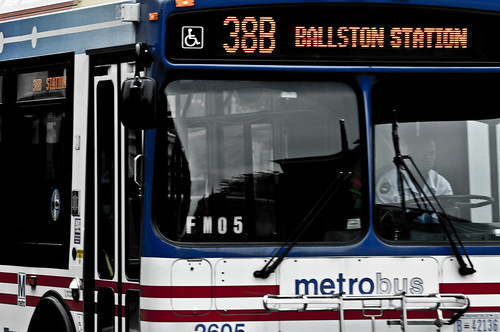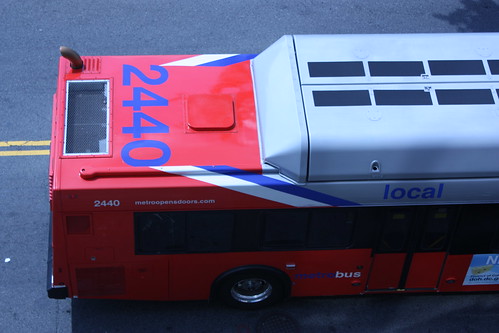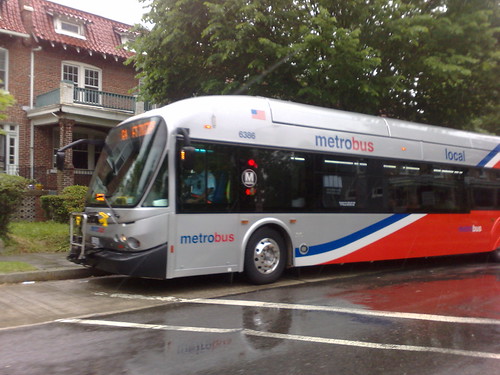
”
courtesy of ‘Chris Rief aka Spodie Odie’
Welcome to another edition of DC Mythbusting. This week we’re looking into the Metrobus system. The rail system is easy enough to understand– it is organized by color, with five lines in total. But there are over 300 bus routes serving the DC area, so the color system wouldn’t work (though I would love to ride the Burnt Sienna line or the Dandelion line). So how are the Metrobus routes named? Why do some have a letter and a number, some a number and a letter, and others just have a number? Read on for the answer!
DC had several successful streetcar companies back in the nineteenth century and much of the city was served by streetcar routes, but by the time of the Great Depression many of these streetcars were forced to consolidate. By the 1930s, many of the streetcar lines were being converted to bus lines. To keep it all straight, a naming/numbering system was established in 1936 for the consolidated routes within the Capital Transit Company. Streetcar lines were given numbers (1 through 9, starting in Rosslyn and going around the city clockwise), bus lines were given letters (A through Z, starting in the far southeast and running counter-clockwise around the city), and individual routes would add a number after that initial number or letter, with even digits signifying all-day routes and odd digits signifying rush-hour service only. Many of today’s bus routes take their names from this early naming system.

‘metro bus’
courtesy of ‘sciascia’
For example, the Mount Pleasant streetcar line was Line 4 in the streetcar numbering system. There were two routes that ran on that line, the 40 and the 42 (both with all-day service, as indicated by the even number). Streetcars ran to Mount Pleasant until the 1960s, when they were replaced by buses. The buses took the names of the streetcars, which is why you can still catch the 42 up to Mount Pleasant all day, but you can only take the 43 during rush hour. This also explains the naming of the 30’s buses on Pennsylvania Avenue (which replaced Line 3 – Pennsylvania Avenue on the streetcar system) or the 52/53/54 on 14th Street (which replaced Line 5 – 14th Street on the streetcar system).
Many of the letter routes also reference the bus routes laid out in 1936. For example, the G line of buses served Northwest and Brookland, and today the G2 serves Georgetown and Brookland. The S line of buses served 16th Street, which led to the S1/S2/S4/S9 buses that run up and down 16th Street now. The X line served H Street NE, and today you can still catch the X1, X2, or X3 to H Street. So that explains a lot of the letter-number combinations out there.

‘Super Cool New 64 Fort Totten Bus’
courtesy of ‘Wayan Vota’
Virginia’s numbering system is a bit different in that it uses a number-letter system (the 38B or the 5A, for example) rather than the letter-number system frequently seen in the Metrobus routes serving Maryland and the District. This is because there were two other companies running the Virginia lines, and they numbered their routes to distinguish them from the routes running in Maryland and the District.
So the reason there’s no consistency in system-wide bus route numbering is mostly due to the conversion of streetcar lines over time and the fractured ownership of DC-area transit systems in the past. Several different companies were running streetcars and buses in the era before Metro arrived on the scene, and it made more sense to preserve the names of the lines than to shake things up.
Wondering where your bus route came from? Here’s the general rule:
- If it’s just a number, it probably originated from a streetcar line. This is true for the 30s, 40s, 50s, 60s, 70s, 80s, and 90 series buses that exist today.
- If it’s a letter and a number, it’s likely that it originated from one of the Capital Transit Company’s bus lines. Many of these routes still serve the same areas that they served back in the early 1900s.
- If it’s a number and a letter, you’re probably in Virginia. Many of these routes have been around for a long time too.
The mystery of the seemingly random bus numbering system is solved! So even though the route names don’t make all that much sense today, it’s nothing new: DC-area commuters have been confused by the bus naming system for almost eighty years.
Pingback: Tweets that mention DC Mythbusting: A Bus By Any Other Name » We Love DC -- Topsy.com
What about N22 running from SE to Union Station? I assume the N stands for “New” but I don’t know about the number.
You guys did a great job, except the G2 doesn’t run to Brookland, it runs from Georgetown to Howard. The G8 runs from Farragut West to Avondale (via Brookland).
Ditto Ashley’s comment.
And what about the P6, which supposedly replaced the Eckington and Soldiers’ Home Streetcar line and remains totally in the District (along with the P1 and P2)?
Pingback: The Morning Metropolitan | The Georgetown Metropolitan
Thanks for setting me straight on the G2!
I don’t know about the N22– the N line originally served Massachusetts Avenue.
And the old 1936 P line served Anacostia and North Capitol Street, so I’m guessing that’s where the P6 came from.